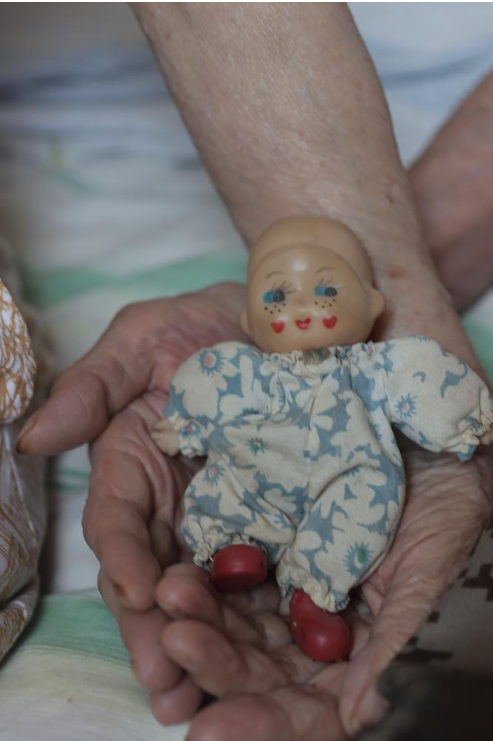In this quietly arresting photographic series, Ciel Wang turns her lens toward the most intimate of subjects: the aging bodies of her grandparents, rendered with a tenderness that transcends mere documentation. What emerges is a meditation on time’s passage, where wrinkled skin and sunspots become landscapes of memory, and where the fading of the body stands in poignant contrast to the persistence of love. The work operates on multiple levels, as personal archive, as aesthetic reclamation, and as a challenge to conventional representations of aging, while its delicate interplay of texture, object, and floral motif invites viewers to reconsider their own relationship to senescence and familial bonds.
Ciel Wang is a fine art photographer and visual artist from China, currently living in the UK. Her artistic practice is rooted in exploring the subtle emotional dialogues between people and their environments. Her work often captures transient, contemplative moments, weaving together natural elements and personal narratives to evoke layered emotional responses. This sensibility infuses The Mark of Jasmine, where delicate details from the textures of skin to the presence of familiar objects and flowers become carriers of memory, tenderness, and enduring connection.
The photographs of the grandparents’ skin are particularly striking in their refusal to aestheticize decay, yet their simultaneous revelation of unexpected beauty. The close-ups of age spots, scars, and bruises, which imperfections that the subjects themselves might view with discomfort, that are transformed into something resembling abstract expressionist compositions. Here, the spots sprawl like inkblots, their irregular edges echoing the petals of jasmine blossoms. This visual rhyme between human markings and floral forms suggests a quiet but radical proposition: that aging, often framed in Western culture as a process of decline, might instead be seen as a kind of natural patterning, as much a part of life’s design as the blooming of flowers. The images recall Karl Blossfeldt’s seminal plant studies, in which organic structures were revealed as intricate, almost architectural forms. Yet where Blossfeldt sought universal geometries in nature, this series finds them in the human body, asserting that time’s markings are not flaws but evidence of a life lived.
The motif of jasmine complicates this reading further, layering personal narrative onto the visual allegory. The artist recounts how her grandmother would place fresh blossoms by her pillow, an act of quiet love that becomes, in the context of the photographs, a metaphor for the transmission of memory itself. In one particularly resonant image, a cluster of jasmine rests in the hollow of a wrinkled palm, the contrast between fragile petals and veined skin underscoring the tension between transience and endurance. In one particularly resonant photograph, a jasmine flower is quietly pinned behind the grandma’s ear, its white petals responding to the flower-like spot on one cheek; in another, wrinkled hands are delivering two beautiful blossoms. We are invited to imagine the texture of that skin, the weight of those flowers, the warmth of that hand—and by extension, the decades of care that they have provided.
This tactile quality extends to the inclusion of childhood toys preserved in the grandparents’ home. Photographed as still lifes amidst domestic surroundings, these objects take on a forgotten talismanic quality, their stubborn materiality standing in stark. These objects transcend their original purpose to become physical manifestations of enduring love, living testaments to an unbroken bond. Their unchanging presence in the household mirrors the constancy of familial affection, even as the grandchild who once played with them has grown. The artist captures these toys not as nostalgic artifacts, but as cherished participants in an ongoing relationship, their material permanence standing in poignant contrast to the natural changes of aging bodies elsewhere in the series.
Technically, the photographs achieve this emotional resonance through careful attention to light and composition. The skin studies, often shot with raking side light, emphasize every crease and shadow, transforming biological detail into something approaching landscape. The shallow depth of field in the images of jasmine and toys creates a softness at the edges, a visual metaphor for the way memory blurs and shifts over time. The series never loses sight of its human core, the images are unflinching in their intimacy, yet never exploitative; they acknowledge the vulnerability of their subjects while asserting their dignity.
What ultimately emerges from this body of work is neither a lament nor a celebration of aging, but something more nuanced—an acknowledgment of its complexity, its sorrows and its unexpected gifts. The markings of age are at once a record of loss and a testament to endurance, just as the flowers are both fleeting and recurring. By training her lens on these intersections, Ciel does not simply document her grandparents’ aging, they reframe it, offering a vision in which time’s passage is not erased but reinterpreted, its traces rendered as natural and as beautiful as blossoms on a branch.
This is photography as an act of love, but also as an act of resistance—against a culture that fears aging, against the erasure of memory, against the idea that time leaves only damage in its wake. The images do not shy away from the realities of the body’s decline, yet they insist, quietly but firmly, that within that decline there remains pattern, meaning, and even grace. In doing so, they invite us to reconsider not just how we see our elders, but how we might one day see ourselves.


